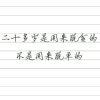-

- 斯巴达汉子 2022-01-31
子查询注意的10个问题
1.子查询语法中的小括号
2.子查询的书写风格
3.可以使用子查询的位置:where,select,having,from后面使用子查询
4.不可以使用子查询的位置:group by后面不可使用子查询
5.强调:from后面的子查询---
6.主查询和子查询可以不是同一张表
7.一般不在子查询中使用排序;但在Top-N分析问题中,必须对子查询排序
8.一般先执行子查询,再执行主查询;但相关子查询例外
9.单行子查询只能使用单行操作符;多行子查询只能使用多行操作符;
10.注意:子查询中是null值问题
1---如果没有小括号,语法是错误的
2----书写风格好,方便阅读
3----
单行子查询---仅仅返回一条记录
多行子查询---返回多行记录,2行及其以上
select empno,ename,sal,(select job from emp where empno=7839) 第四列
from emp;
select deptno,avg(sal)
from emp
group by deptno
having avg(sal) > (select max(sal)
from emp
where deptno=30);
-- 这having不能用where替代,有avg
select *
from(select empno,ename,sal from emp);
-- from 中加子查询的,用的很多
-- 括号里面,相当于一个新的结果集
4 -- group by 后不能使用子查询
-- 错误示例
select avg(sal)
from emp
group by (select deptno from emp);
5.from后面的子查询
select *
from (select empno,ename,sal,sal*12 from emp);
--通过12*sal计算出年薪
6.主查询和子查询不是一张表
-- 查询销售部员工
select *
from emp
where deptno=(select deptno
from dept
where dname='SALES');
-- 多表查询的方式解决同样问题,相对上面,这里数据库访问一次,效率得根据实际数据量模式
select e.*
from emp e,dept d
where e.deptno=d.deptno and d.dname='SALES';
7.一般不在子查询中使用排序;但在Top-N分析问题中,必须对子查询排序
select rownum,empno,ename,sal
from emp
where rownum<3
order by sal desc;
select rownum,empno,ename,sal from emp order by sal desc;
行号永远按照默认的顺序生成
行号只能使用< <=不能使用> >=
select rownum,empno,ename,sal
from (select * from emp order by sal desc)
where rownum<=3;
8.一般先执行子查询,再执行主查询;但相关子查询例外
-- 查询在所在部门,工资高于平均工资的员工
select empno,ename,sal,(select avg(sal) from emp where deptno=e.deptno) avgsal
from emp e
where sal > (select avg(sal) from emp where deptno=e.deptno);
9.单行子查询只能使用单行操作符
多行子查询只能使用多行操作符
返回一条记录---单行子查询
返回2条及其以上----多行子查询
单行子查询示例1:
查询员工信息:
1.职位与7566员工一样
2.薪水大于7782的薪水
select *
from emp
where job = (select job from emp where empno=7566) and
sal > (select sal from emp where empno=7782);
单行子查询示例2:
查询工资最低的员工信息
select *
from emp
where sal = (select min(sal) from emp);
单行查询示例-3:
查询最低工资大于20号部门最低工资的部门号和部门的最低工资
select deptno,min(sal)
from emp
group by deptno
having min(sal) > (select min(sal)
from emp
where deptno=20);
多行操作符-
in--- 等于列表中的任何一个
any--- 和子查询返回的任意一个值比较
all--- 和子查询返回的所有值比较
多行操作符in:
查询部门名称是SALES和ACCOUNTING的员工信息
select *
from emp
where deptno in (select deptno from dept where dname='SALES' or dname='ACCOUNTING');
多表查询实现:
select e.*
from emp e,dept d
where e.deptno=d.deptno and (d.dname='SALES' or d.dname='ACCOUNTING');
tips:如若不加括号,按照and,or从前到后次序执行;
多行操作符any
示例:查询工资比30号部门任意一个员工高的员工信息
select *
from emp
where sal > any (select sal from emp where deptno=30);
select *
from emp
where sal > (select min(sal) from emp where deptno=30);
多行操作符:all
示例:查询工资比30号部门所有员工高的员工信息
select *
from emp
where sal > all (select sal from emp where deptno=30);
select *
from emp
where sal > (select max(sal) from emp where deptno=30);
10.子查询中的null问题
单行子查询中的null问题----结果是空值
多行子查询中的null问题
示例:查询不是老板的员工
select *
from emp
where empno not in (select mgr from emp);
-- 因为子查询中有null,导致返回空数据
select *
from emp
where empno not in (select mgr from emp where mgr is not null);
*******************************************************
- 0赞 · 0采集
-

- 斯巴达汉子 2022-01-31
SQL> select *
2 from emp
3 where sal > (select sal
4 from emp
5 where ename='SCOTT');
EMPNO ENAME JOB MGR HIREDATE SAL COMM
---------- ---------- --------- ---------- -------------- ---------- ----------
DEPTNO
----------
7839 KING PRESIDENT 17-11月-81 5000
10
- 0赞 · 0采集
-

- 慕设计4302654 2021-10-12
子查询:解决不能一步求解的查询
实例:查询比SCOTT的工资高的员工

select *
from emp
where sal > (select sal
from emp
where ename ='scott');
- 0赞 · 0采集
-

- 波阿斯 2020-03-31
子查询概述
-
截图0赞 · 0采集
-

- 波阿斯 2020-03-31
单行子查询与多行子查询
-
截图0赞 · 0采集
-

- 慕粉13485244983 2020-03-15
- 层次查询
-
截图0赞 · 0采集
-

- qq_慕标5384168 2020-03-02
子查询
比SCOTT的工资高的员工信息
1、查询SCOTT的工资
select sa; from emp where ename='SCOTT';
2、比SCOTT工资高的员工信息
select * from emp where sal>3000;
子查询代码
select * from emp where sal >(select sal from emp where ename='SCOTT');
- 0赞 · 0采集
-

- snip 2020-01-09
- 提示一下吧!
-
截图0赞 · 0采集
-

- 慕莱坞3131685 2019-06-26
- 子查询举例
-
截图0赞 · 0采集
-

- 慕前端0191614 2019-06-12
子查询就是解决不能一步查询到的结果,用select嵌套。
select sal from emp where ename='scott';
select * from emp where >3000;
select * from emp
where sal > (select sal
from emp
where ename='scott');
- 1赞 · 2采集
-

- qq_星_20 2019-03-12
子查询概述
子查询使用
子查询类型
- 0赞 · 0采集
-

- 慕无忌3046761 2018-10-29
- 层次查询
- 0赞 · 0采集
-

- 慕仰021355 2018-10-25
- rownum不能用<=
-
截图0赞 · 0采集
-

- 慕仰021355 2018-10-25
- rownum不能用<=
-
截图0赞 · 0采集
-

- 不鸣则已丶 2018-07-30
两个查询嵌套,把其中一个select当做条件
select *
from emp
where sal > (select sal
from emp
where ename='SCOTT');- 0赞 · 2采集
-

- qq_故事中的人_0 2018-06-24
查询工资比scott高的员工的工资;
select *
from emp
where sal>(select sal from emp where ename='SCOTT');
- 1赞 · 0采集
-

- qq_瓪_0 2018-06-13
>>子查询注意的10个问题
1.子查询语法中的小括号
2.子查询的书写风格
3.可以使用子查询的位置:where,select,having,from
(1) select 必须是单行子查询
select 工号,姓名,工资,(select 职位 from 员工表 where 工号='100')
from 员工表
(2) having
select 部门号,ags(工资)
from 员工表
group by 部门号
having ags(工资) > (select max(工资)
from 员工表
where 部门号 = 30)
(3)from
select *
from(select 员工号,姓名,工资
from 员工表)
4.不可以使用子查询的位置:group by
5.强调:from后面的子查询
select *
from (select 员工号,姓名,工资 月薪,工资*12 年薪 from 员工表)
6.主查询和子查询可以不是同一张表
--子查询
select *
from 员工表
where 部门号 = (select 部门号
from 部门表
where 部门名称 = '销售部')
--多表查询
select t1.*
from 员工表 t1,部门表 t2
where t1.部门号 = t2.部门号
and t2.部门名称 = '销售部'
7.一般不在子查询中,使用排序;但在Top-N分析问题中,必须对子查询排序
**rownum 行号,伪列
*行号永远按照默认的顺序生成
*行号只能使用 <,<=;不能使用 >,>=
select rownum,员工号,姓名,工资
from 员工表
(1)top-n 前三名
select rownum,员工号,姓名,工资
from(select *
from 员工表
order by 工资 desc)
where rownum <= 3
8.一般先执行子查询,再执行主查询;但相关子查询例外
(1)**相关子查询 (子查询使用了主查询字段)
select 员工号,姓名,工资,
(select avg(工资) from 员工表 where 部门号 = t1.部门号) 部门平均工资
from 员工表 t1
where 工资 > (select avg(工资)
from 员工表
where 部门号 = t1.部门号)
--
select 员工号,姓名,工资
from 员工表 t1
where 工资 > (select 部门号,avg(工资)
from 员工表
group by 部门号
having 部门号 = t1.部门号)
--
select t1.员工号,t1.姓名,t1.工资,t2.部门平均工资
from 员工表 t1,
(select 部门号,avg(工资) 部门平均工资
from 员工表
group by 部门号) t2
where t1.部门号 = t2.部门号
and t1.工资 > t2.部门平均工资
9.单行子查询只能使用单行操作符;多行子查询只能使用多行操作符
多行操作符 in/any/all
--in
--any
select *
from 员工表
where 工资 > any(select 工资
from 员工表
where 部门号 = 30)
--等价
select *
from 员工表
where 工资 > (select min(工资)
from 员工表
where 部门号 = 30)
--all
select *
from 员工表
where 工资 > all(select 工资
from 员工表
where 部门号 = 30)
--等价
select *
from 员工表
where 工资 > (select max(工资)
from 员工表
where 部门号 = 30)
10.注意:子查询中是null值得问题
单行子查询null值问题
多行子查询null值问题
**not in
a not in (10,20,null)
a != 10 and a != 20 and a != null
all
select *
from 员工表
where 员工号 not in (select 老板号
from 员工表
where 老板号 not null)
- 0赞 · 0采集
-

- Tkilous 2018-06-05
子查询实例
-
截图0赞 · 0采集
-

- 慕斯9756157 2018-06-03
例:查询工资比Scott高的员工
select * from emp where sal > (select sal from emp where ename = 'SCOTT' );
- 1赞 · 0采集
-

- 慕的地6756772 2018-03-08
- 子查询语法
-
截图0赞 · 0采集
-

- 时过境迁8 2017-08-10
- 例:查询工资比Scott高的员工 select * from emp where sal > (select sal from emp where ename = 'Scott' );
- 0赞 · 1采集
-

- Antares96 2017-07-30
- 使用子查询解决不能一步完成的查询(查询的嵌套) 单行子查询,多行子查询
- 0赞 · 0采集
-

- 慕先生625673 2017-06-15
- 子查询分为单行子查询和多行子查询 例子:查询比scott工资高的员工信息 select * from emp where sal>(select * from emp where ename = 'SCOTT');
- 0赞 · 0采集
-

- 慕九州5124105 2017-06-14
- 问题不能一步出结果的查询,就要涉及到子查询。。。
- 0赞 · 0采集
-

- KingStar1 2017-05-19
- 主查询中嵌入子查询!
-
截图0赞 · 0采集
-

- KingStar1 2017-05-19
- 子查询分为单行子查询和多行子查询!!!
-
截图0赞 · 0采集
-

- 慕尼黑5307359 2017-04-25
- connect by start with
- 0赞 · 0采集
-

- qq_奋斗_92 2017-04-22
- 子查询 select * from emp where ename='scott'; select sal from emp where sal>3000; select * from emp where sal>(select sal from emp where ename='scott');
- 0赞 · 0采集
-

- 把尾巴藏好 2017-04-20
- 子查询 即select语句的嵌套
- 0赞 · 0采集
-

- 众神之墓 2016-10-19
- 层次 查询 connect by。树状图 上一层 等于。这一层的什么什么
-
截图0赞 · 0采集


























